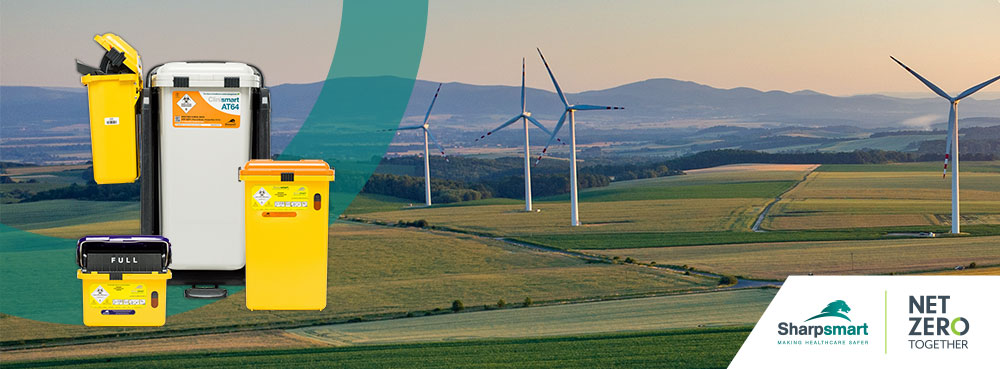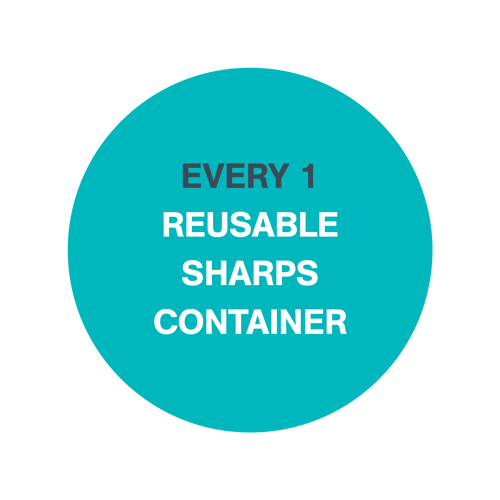What Is Greener NHS and How Will It Reach Net Zero Carbon?

The environment is changing at an increasing pace and the threat of climate change to both people and the planet is already having an impact on public health and as a result, the NHS. In recent years, the NHS has made a commitment to becoming a greener organisation and is the first national health service to commit to reaching net zero carbon emissions.
This net zero future in which healthcare is more sustainable and environmentally friendly will be achieved through a variety of methods and initiatives; some of these Greener NHS initiatives include implementing more energy-efficient technologies, reducing the use of single-use plastics, and supporting the development of sustainable practices.
TOPICS WE WILL COVER:
1 / What is the greener NHS initiative?
2 / How will the NHS reach net zero carbon emissions?
3 / Healthcare waste and the greener NHS initiative
4 / What is the 20-20-60 waste split?
What is the Greener NHS Initiative?
“Greener NHS” is the term being used to describe the efforts of the NHS to reduce its environmental impact and contribute to a more sustainable, environmentally friendly healthcare system.
One aspect of the Greener NHS initiative is the goal of achieving net zero carbon emissions by the year 2040. This includes reducing energy use, minimising the use of single-use plastics, promoting the use of renewable energy sources, and improving waste management practices.
A key feature of the Greener NHS initiative is the emphasis that everyone involved with the NHS will have a role to play in reducing the impact the NHS has on the environment and by extension, public health.

How Will the NHS Reach Net Zero Carbon Emissions?
The NHS is doing more to tackle carbon emissions than only dealing with those it directly controls, it’s also looking to reduce the emissions it can influence.
To reach its goal of becoming the world’s first net zero national health service, the NHS has set two objectives:
- For emissions the NHS directly controls: Reach net zero by 2040, with an ambition to reach an 80% reduction by 2028 to 2032.
- For emissions the NHS can influence: Reach net zero by 2045, with an ambition to reach an 80% reduction by 2036 to 2039.
Some of the key strategies for reaching this net zero goal include:
Renewable Energy and Efficiency
As well as looking at ways to increase its use of renewable energy sources, such as solar panels and wind turbines; the NHS is also working to reduce energy usage and implement more energy-efficient technologies and practices within its hospitals and facilities.
Improving Healthcare Waste Management
The NHS generates a large amount of waste and has historically sent high volumes of waste to landfill or high-temperature incineration. By improving waste management practices, introducing new waste streams and educating staff on correct waste segregation, the carbon emissions associated with waste disposal will be drastically reduced.
Adopting New Practices
A sizable part of delivering a net zero NHS involves developing and adopting new practices and supporting the development of new, sustainable technologies and innovations within the healthcare industry. Some of these new practices include the use of electric vehicles for patient transport, the use of technology-enabled care services, and a higher adoption rate of reusable equipment.
Reducing Single-Use Plastics
There’s a huge push from the NHS to reduce its reliance on single-use plastics, which contribute significantly to environmental pollution. Minimising the use of single-use plastics includes the introduction of reusable, rather than disposable, medical equipment and the promotion of recycling initiatives within healthcare facilities.
Decarbonising the Supply Chain
With more than 80,000 suppliers providing the NHS with products and goods, the supply chain is counted as a substantial source of carbon emissions and although the NHS doesn’t have direct control of these emissions, it can influence change.
By 2030, the NHS will no longer purchase products or services from suppliers that aren’t decarbonising their own processes to meet or exceed the NHS commitment to net zero. As well as influencing change amongst their suppliers, the NHS will be looking into the more efficient use of supplies and low-carbon alternatives.
More Green Spaces
One of the strategies the NHS is using for offsetting carbon emissions is increasing green spaces and trees on NHS sites. As well as the advantages and benefits this initiative brings from an environmental perspective and improving air quality, it’s also beneficial for mental health and provides opportunities for health and social prescribing.
Healthcare Waste and the Greener NHS Initiative
Healthcare waste has been identified as a key area that needs to be carefully managed as it’s a significant contributor to the carbon emissions the NHS controls directly; not only limited to hospitals but also other healthcare facilities such as clinics and surgeries.
To address this issue, the Greener NHS initiative is working to optimise and improve the management of healthcare waste; reducing the amount of waste produced, recycling and reusing materials where possible and safely disposing of hazardous waste.
Attention will also be paid to an area that’s sometimes overlooked when it comes to healthcare waste; the containment and transportation methods before it even reaches the processing and treatment stage of the journey.
By addressing healthcare waste as part of its “Greener NHS” initiative, the NHS is working to reduce its carbon emissions and make its operations more environmentally sustainable.
What is the 20-20-60 Waste Split?
The overtreatment of waste is easily avoidable when waste is segregated and sorted correctly; diverting the majority of it away from carbon-intensive treatments such as high-temperature incineration. An informed and educated approach leading to correct segregation can also reduce overall waste and maximise recycling. NHS England encourages a 20-20-60 waste split which means:
- 20% of waste sent for high-temperature incineration;
- 20% of waste sent for alternative treatment (AT);
- 60% of waste classified as offensive waste, which can be converted into energy.
This 20-20-60 waste split massively reduces the high levels of HTI waste that are currently being generated as a result of bad segregation practices and encourages a more sustainable and cost-effective solution to healthcare waste management.

On the Route to Net Zero
As we’ve seen, the Greener NHS initiative is an important step towards making the NHS a more environmentally friendly and sustainable organisation.
Another exciting feature highlighted by Greener NHS is that for the very first time, every NHS Trust in England now has a green plan in place. That’s 212 NHS Trusts, covering more than 1,000 hospitals and healthcare facilities.
By actively working towards achieving its goal of net zero carbon emissions and by addressing healthcare waste as part of this effort, the NHS is taking a holistic approach to reducing its carbon footprint and protecting both the environment and the public.
Let's Talk!
Your time is valuable, and we don’t want to play hard to get. You can either phone us directly on the details listed on our contact page, or feel free to fill out this short form and one of our team members will get back to you as quickly as possible.
